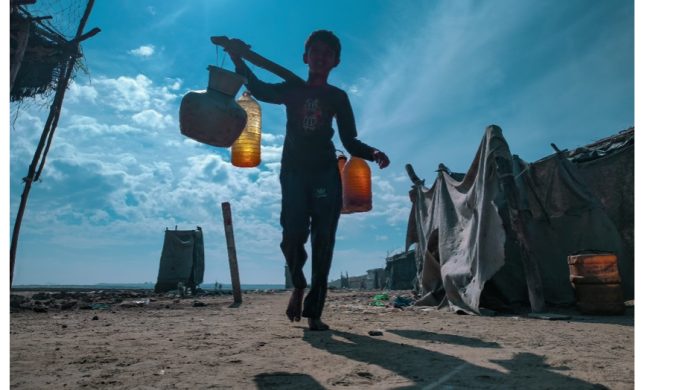
Cox’s Bazar, a region famous for its natural beauty, traditional industries, and coastal culture, is facing an unprecedented crisis due to climate change and so-called development projects. The once-thriving coastal economy based on agriculture, salt production, and fishing is now crumbling under the pressure of rising sea levels, unpredictable weather patterns, and urbanization.
The Disruption of Tradition:
For generations, the people of Cox’s Bazar have relied on agriculture and fishing as the cornerstone of their livelihoods. Salt production in Maheshkhali, rice cultivation in Chakaria, and fishing in Teknaf were not just economic activities, but a cultural identity. However, the increasing salinity in the soil, the loss of arable land due to sea level rise, and extreme weather events like cyclones are making these traditional practices unsustainable.
According to recent climate models, sea levels in the Bay of Bengal are rising at an alarming rate, with estimates suggesting a rise of 0.3 to 0.5 meters by 2050 (IPCC, 2021). This rise is eroding coastal lands, affecting agricultural output and the fishing industry. With saltwater intrusion rendering agricultural land infertile and forcing fishermen to go further out to sea for catch, these traditional livelihoods are becoming increasingly unviable.
Development or Destruction?
In the name of development, large-scale projects are being implemented in the region, further accelerating environmental degradation. Smart cities, economic zones, and tourism hubs are being constructed on land that was once rich with agricultural resources. These projects, while promising economic growth, are driving thousands of acres of farmland and mangrove forests into extinction. In areas like Chakaria, fertile land is being replaced by residential and commercial developments, leaving behind barren, unproductive soil.
The construction of infrastructure, such as roads, resorts, and industrial zones, is being carried out without proper environmental consideration, often displacing local communities and wildlife. Local voices are seldom heard in the planning and execution of these projects. The people who have lived off the land for generations are forced into a situation where they lose their homes and livelihoods for a so-called ‘greater good’ that often only benefits outside investors.
Unemployment and Climate Migration:
As agricultural and fishing industries collapse, the region’s youth are left with few options. Many seek employment in nearby cities or abroad, but many also face unemployment and a sense of hopelessness. According to the International Organization for Migration (IOM), climate change is expected to increase migration from vulnerable coastal areas like Cox’s Bazar, with many migrating internally or internationally in search of new opportunities.
However, the majority of displaced people, especially the youth, face significant challenges in finding new livelihoods. Without access to climate-resilient jobs or sustainable vocational training programs, these individuals are often caught in a cycle of poverty and despair.
The Blindness of Policy Makers:
At the heart of the crisis is the apathy of policymakers. National development plans and climate policies are often formulated without a thorough understanding of the local realities and needs of the people affected by climate change. Local communities are excluded from the decision-making process, and the government’s climate adaptation funds seldom reach the people who need them the most.
In fact, a 2020 study by the Bangladesh Climate Change Trust Fund (BCCTF) found that only 27% of the funds allocated for climate adaptation were successfully distributed to local communities. The majority of funds remain in the hands of large-scale projects that do little to address the specific needs of the local population.
Solution:
Climate-Conscious Development A new vision for development is urgently needed — one that integrates climate resilience and justice at its core. Climate-conscious development must prioritize sustainable agriculture, fisheries, and eco-friendly infrastructure. By investing in climate-resilient practices, such as salt-tolerant crops and sustainable fishing methods, local communities can begin to recover and adapt to the changing climate.
Furthermore, the inclusion of local communities in the planning and execution of climate adaptation strategies is essential. Policies must be designed that empower local people, provide access to green jobs, and ensure that those most affected by climate change have a voice in the decisions that impact their future.
Cox’s Bazar is at a crossroads. The region faces not only the threat of environmental collapse but also the erosion of its cultural identity and economic foundation. However, with a shift towards climate-conscious development and an emphasis on local empowerment, there is still hope for the future. The people of Cox’s Bazar have the resilience to adapt, but they need the support of both national and international communities to ensure a sustainable, just, and climate-resilient future.
Reference:
• The IPCC report (2021) highlights the rise of sea levels in the Bay of Bengal, posing significant risks to low-lying coastal regions like Cox’s Bazar.
• The International Organization for Migration (IOM) emphasizes the role of climate change in increasing migration from vulnerable areas.
• The Bangladesh Climate Change Trust Fund (BCCTF) 2020 study shows the limited success of climate adaptation funds reaching local communities.
Economist/10April/ZI/Climate